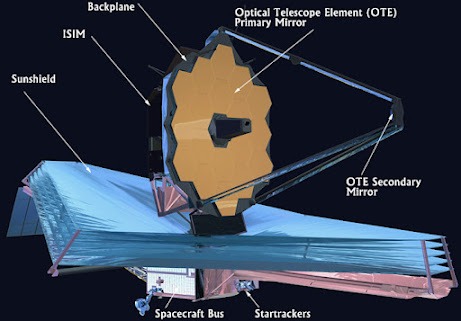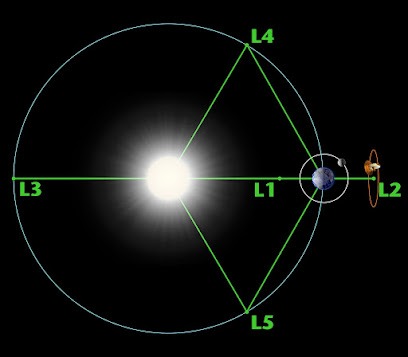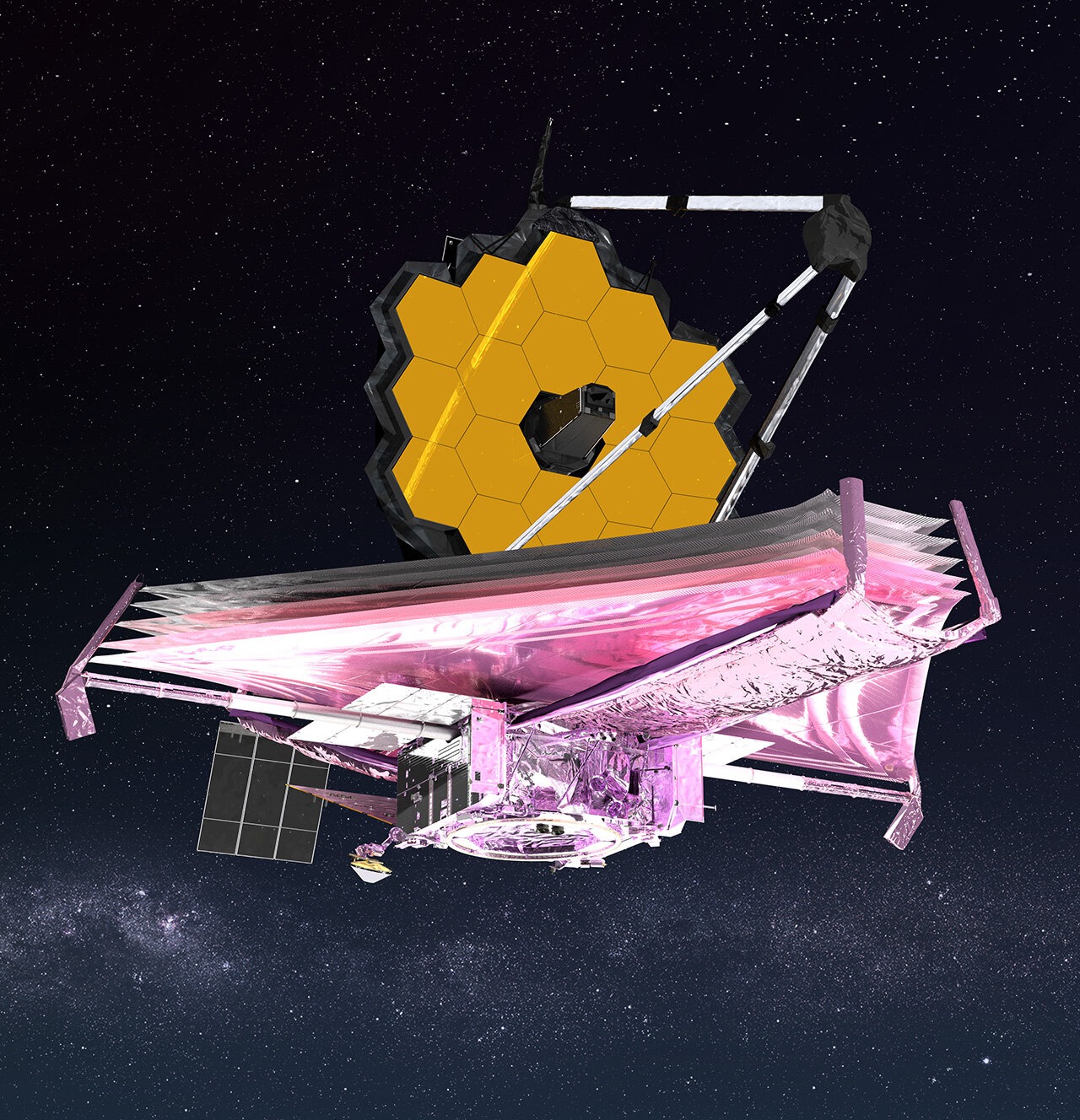Know about world’s largest Space Telescope: JWST

JWST is going to give us our first detailed glimpse of our early universe from which we and everything we know was born. It is a 10-billion-dollar endeavour. It is the successor of Hubble Space Telescope and optimised for Infrared wavelengths.
Hubble was the first telescope that was established in space and does Optical and near Infrared imaging. It has done some game changing discoveries in 25 years of life span like find finding exoplanet, super massive black hole, saw collision & merging and growth of galaxies. In spite of all these achievements Hubble has one flaw that it can’t observe some place of universe, we need more powerful telescope than Hubble. So JWST comes in picture.


JWST is a joint venture of NASA, ESA (European Space Agency), CSA (Canadian Space Agency). JWST was expected to be launched on 2007 but after 16 launch delays it finally launched by Ariane 5 (European heavy lift launch vehicle) from the European spaceport in Kourou, French Guiana, On 24 Dec 2021. And safely reached on destination i.e. Second Sun-Earth Lagrange point L2 which is located 1.5 million miles from earth on 24 Jan 2022. It already deployed its vast sunshield during its journey. For the next 5 months it’ll cool down itself and simultaneously it’ll deploy its 18 primary mirrors. At first life span of JWST guessed around 10 years but it still has enough fuel after using so much deep space engine burns its life span increase to 20 years.
Why it is called “James Webb”?
Originally it was called “Next generation space telescope (NGST)” but later it called JWST named after James Edwin Webb (administrator of NASA) known for leading the Apollo missions.
Why was JWST established far from earth (1.5 million km)?
Our eyes can only see the one portion of Electromagnetic spectrum which is Visible light. JWST specialised only in Infrared, so its mission is to capture faint IR signals coming from extremely far objects so that we can collect more info about them, so to achieve this it’s important there will no heat source available in between or else it’ll blind the JWST. That’s why JSWT has to operate at -230 ℃, to protect from heat from Sun, Moon and Earth, it has sunshields and these sunshields will most effective when Sun, Earth and Moon are always in same line that’s the reason JWST is placed on second L2 (Lagrange) point.

What is Lagrange point and why L2 is so important?
But before this we have to know what’s the “Three body problem”? “Is there any stable configuration, in which three bodies could orbit each other, yet stay in the same position relative to each other?”
This problem was solved by “Joseph Louis Lagrange”, he told 5 points are possible they named L1, L2, L3, L4, L5. Lagrange points are special points in the space where small objects like satellites, can stay more or less in the same position relative to the gravitational bodies that they are travelling with. This happens because the gravitational pull from two bodies precisely equals the centripetal force which required for the small object (satellite) to move with gravitational bodies, while using a minimal amount of fuel to stay in position.

Example: On these points Sun’s and Earth’s gravity help each other to stabilise a satellite on a fixed position.

As we can see L1, L2, L3 are in straight line, but L4, L5 are points off equilateral triangle. L4 & L5 are called as stable point, means object don’t need as assistance to orbit these points.
But L1, L2, L3 are meta stable points means objects who orbit these points drifts with time from their position so to maintain their position they have to use rocket thrusters.
JWST is an Infrared telescope, Infrared is heat and the heat emanating from the Sun would completely saturate its sensors and make observing the impossible. One more advantage of being on L2 point, we can establish continued communication with the telescope as it’ll be on same position relative to earth. Hubble was affected by earth shadow in every 90 mins but JWST will not affected because it will orbit the L2 point rather than stay on it.
How far can JWST see?
Using its IR camera, it can see objects which is 13.6 billion Light Years far.
Missions of JWST:
- Examine the first light after Big Bang
- Examine how galaxies form and evolve with cosmic time.
- To study the atmosphere of distant exoplanets.
- To know more about our solar system
- To find the evidence of dark matter
How scientists manage to keep JWST cool?
Sunlight dumping approx 2 Lakh watts of power, and they only want less than a watt of that to get through to the telescope. So, let’s recall 8th standard Physics, Heat can transfer in 3 ways:
- Conduction: where heat is transferred from atom to atom in direct contact with each other.
- Convection: where heat is transferred from the physical movement of atoms.
- Radiation: where heat is transferred by electromagnetic waves.
So, in vacuum we only have two choice, Convection and Radiation.
How these methods manage the heat transfer?
A. First Material choice:
The sunshield needs to be light, strong, resistant from solar radiation and reflective. For such a long list of features Kapton, a type of high-performance plastic is used to make sunshield.
B. Fuel Choice:
The telescope also has thrusters for larger position maintenance. 191 litre (42 gallons) of Hydrazine and 95.5 litre (21 gallons) of its oxidiser Dinitrogen Tetroxide will be stored inside the spacecraft bus that will feed 20 different rocket thrusters scattered around the telescope. There are 8 thruster modules, 2 on each corner of the spacecraft bus. These 16 engines will be fed with Hydrazine only, a monopropellant reaction where the Hydrazine is passed over a catalyst, causing a highly exothermic reaction breaking the Hydrazine down into Nitrogen, Hydrogen and Ammonia.
N2H4(liquid) => N2 + H2 + NH3
The other 4 motors are for orbital and positional control and require more power. They will be fed with both Hydrazine and Dinitrogen tetroxide. This fuel and oxidiser mixture react Hypergolically to form Nitrogen and Water.
2N2H4 + N2O4 => 3N2 + 4H20
Hypergolic meaning, they don’t need an igniter they simply ignite on contact with each other. Hydrazine is an excellent choice for a long-lasting mission like this. The hypergolic reaction means the motors can repeatedly and reliably fire without a point of failure causing issues, like an ignitor breaking. Hydrazine is also stable for long periods at room temperature allowing it to be stored over the expected 10 years life cycle of the James Webb telescope. Between pointing and orbital maintenance, we will run out of fuel at some point.
C. Unfolding sequence:
The truly nerve wrecking process begins on day 7, as the satellite is coasting towards L2. There are over 300 single point of failure in this sequence, this process will take 3 days, and then optical components will unfold. Mid-infrared detection instrument, located in middle needs to be even colder to work correctly. It needs to be 7 ℃ Calvin, for this we need active cooling. JWST includes and cryocooler for this purpose.
Once fully deployed the telescope will begin its calibration phase with each mirror adjusting itself until each of 18 segments have aligned correctly with the secondary mirror, a 0.74 meter convex mirror, which itself has 6 motors to adjust its position.
But the job to get a clear image isn’t done with primary and secondary mirror alone, they focus the light onto the Cassegrain focus which is located inside the aft optics subsystem.
There is a black protrusion in the middle of the primary mirror, which blocks stray light from entering the aperture, inside it there are two more mirrors, one of them being the fine steering mirror and this thing is the world’s most expensive image stabilisation tool. It is controlled by fine guiding system.
Add Comment
You must be logged in to post a comment.








